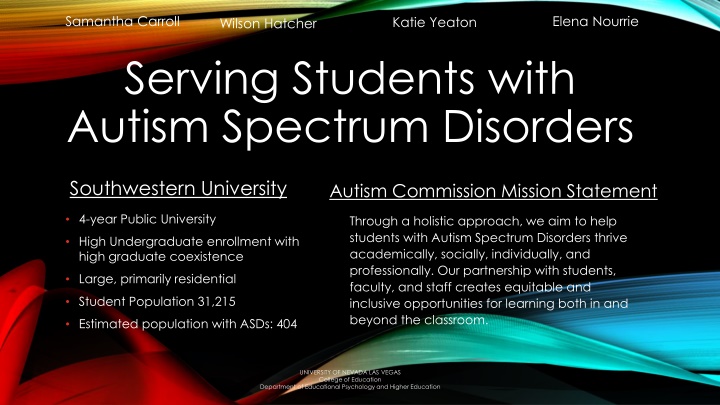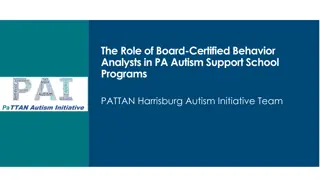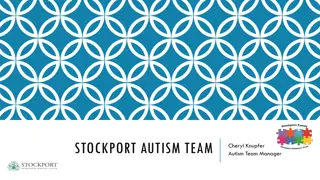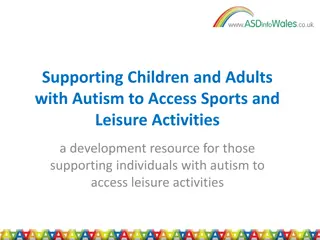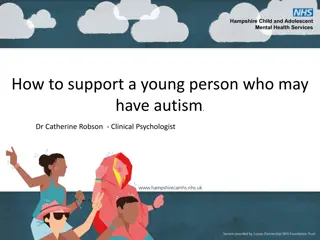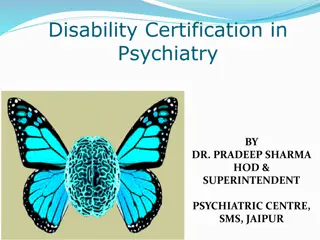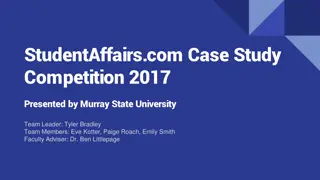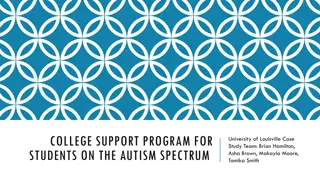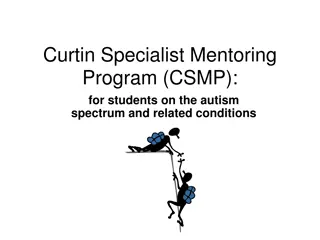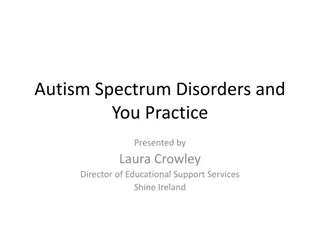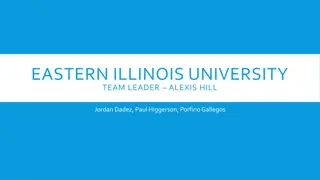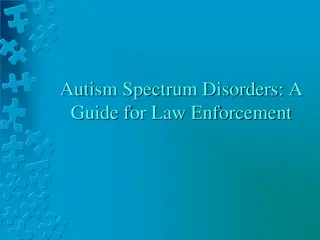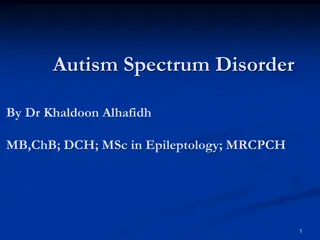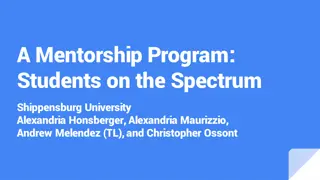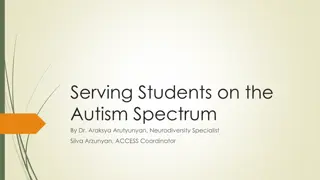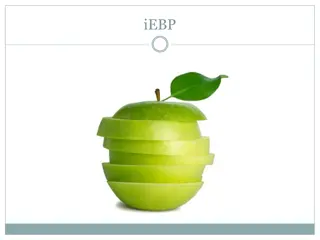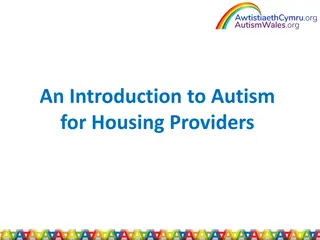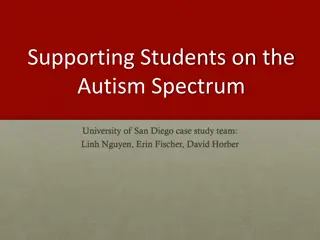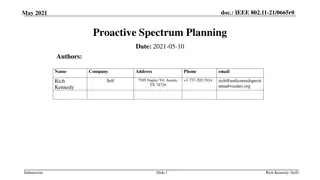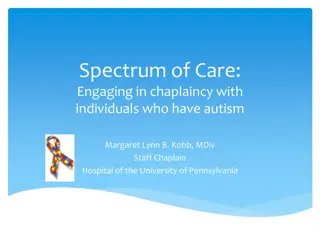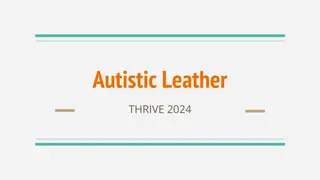Serving Students with Autism Spectrum Disorders at Southwestern University
Through a holistic approach, the Autism Commission at Southwestern University aims to help students with Autism Spectrum Disorders thrive academically, socially, individually, and professionally. The university's mission emphasizes equitable and inclusive opportunities for learning, with a focus on partnerships among students, faculty, and staff. The content covers diagnostic criteria, research theories, academic accommodations, person-centered practices, and the EASE Program, providing valuable insights for supporting individuals with ASD.
Uploaded on Feb 28, 2025 | 1 Views
Download Presentation

Please find below an Image/Link to download the presentation.
The content on the website is provided AS IS for your information and personal use only. It may not be sold, licensed, or shared on other websites without obtaining consent from the author.If you encounter any issues during the download, it is possible that the publisher has removed the file from their server.
You are allowed to download the files provided on this website for personal or commercial use, subject to the condition that they are used lawfully. All files are the property of their respective owners.
The content on the website is provided AS IS for your information and personal use only. It may not be sold, licensed, or shared on other websites without obtaining consent from the author.
E N D
Presentation Transcript
Elena Nourrie Samantha Carroll Katie Yeaton Wilson Hatcher Serving Students with Autism Spectrum Disorders Southwestern University Autism Commission Mission Statement 4-year Public University Through a holistic approach, we aim to help students with Autism Spectrum Disorders thrive academically, socially, individually, and professionally. Our partnership with students, faculty, and staff creates equitable and inclusive opportunities for learning both in and beyond the classroom. High Undergraduate enrollment with high graduate coexistence Large, primarily residential Student Population 31,215 Estimated population with ASDs: 404 UNIVERSITY OF NEVADA LAS VEGAS College of Education Department of Educational Psychology and Higher Education
Autism Spectrum Disorder Diagnostic Criteria Criterion B Criterion A Restricted, repetitive patterns of behavior, interests, or activities. Manifest by at least 2 of 4 symptoms Persistent deficits in social communication interaction. Manifest by 3 of 3 symptoms A1 A2 B1 B2 B3 B4 A3 Problems with social awareness and concept of social relationships Problems with social interaction and response Problems with non-verbal communication Atypical speech, movements, and play Rituals and resistance to change Preoccupations with objects or topics Atypical sensory behaviors Criterion C: Symptoms are present in early childhood, but may not become fully manifest until social demands exceed limited capacities Criterion D: Symptoms together limit and impair everyday functioning Severity Scale Level 1 Level 2 Level 3 Requiring very substantial support Requiring support Requiring substantial support Carpenter, L. (2013). DSM-5 Autism Spectrum Disorder: Guidelines and Criteria Exemplars. Medical University of South Carolina, https://depts.washington.edu/dbpeds/Screening%20Tools/DSM-5(ASD.Guidelines)Feb2013.pdf
Research and Theory Baron-Cen s (1989) Theory of ohMind model suggests social impairments are fundamental to ASDs and reflect difficulties individuals have in understanding the thoughts or feelings of others and social behavior. Autism is a developmental disorder distinguished by impairments in three specific areas: communication, social skills, and behavioral flexibility (Burnette, et al., 2005; Breakey, 2006; Cashin, 2009) Breaking tasks into smaller pieces, providing clear expectations, helping students to identify plans and stay organized (Shmulsky & Gobbo, 2013). Academic accommodations include extended deadlines, additional time on exams, alternatives to group projects and assignments involving public speaking, detailed syllabi and concrete language in lectures (Gobbo & Shmulsky, 2012). Person-centered practices reinforce inclusive environments as provisions match the needs of individual learners; essential to being person-centered is knowing the person and central to knowing the person is knowing how to effectively communicate with them (Breakey, 2006).
Triad of Impairment Wing and Goulds Triad of Impairment http://www.autismtopics.org/t3%20autism%20triad.html
EASE Program Education And Support Environment Mission: Educate campus partners about Autism Spectrum Disorders through regular training and counsel as well as to provide individualized service to students with ASD. The EASE Support team will be housed under Mental Health Services. This includes the Program Coordinator, a Learning Specialist and a Disability Specialist, as well as student workers, graduate assistants, and a doctoral student to serve as Peer Mentors, Communication Coaches, and Social Support Group Leaders
EASE Program Structure Social Skills Support Group Individual Students with ASD Communication Coaching Course Residential Life Faculty Support Academic Services Student Services Career Services Peer Mentor Program Supports Disability Resource Center with specialized knowledge and guidance Collaboration with campus partners on proposed programs, ensuring each program helps address an area of improvement effectively and creatively. EASE Center located in the Office of Mental Health Services. Houses each student s file for regular review to chart student s progress and make adjustments as the develop and
Team Member Roles Program Coordinator Management position responsible for the operations of the EASE Program. Performs administrative duties as well as provides guidance and support for EASE Program Personnel. Reports to the Director of Mental Health Services. Disability Specialist Learning Specialist Primarily responsible for coordinating between Faculty and the Disability Resource Center. Will provide individual Academic Accommodation Plans as well as training to faculty about best practices with ASD Students. Primarily responsible for providing continuous training and support to various student service programs throughout the campus to ensure all programs are addressing the challenges ASD students face. Social Skills Group Leader Weekly support group for ASD Students led by a Doctoral Student Peer Coach Communication Coach Undergraduate Student Workers mentor and socially engage ASD students Graduate Assistants who support ASD students through a developmental communicaiton education curriculum. 3 Credit Hour First Year Experience course.
Self Care and Advocacy Executive Function Academic Skills Social Competence Career Preparation Assistive Technology CURRICULUM CORNERSTONES
Self Care and Self Advocacy Maintaining personal wellness and communicating ones needs Learning Specialist Training programs for RA s and Graduate Assistant Communication Coaches on strategies for ASD students provided by a Learning Specialist from the EASE Program. RA s and Coaches provide regular reports to the Learning Specialist on ASD Students development and progress. Be a campus resource Active listening. Instead of listening to understand and respond, be a sense of support for residents. In some instances this listening will mean engaged body language, while other conversations may involve more suggestions to seek out campus resources or encourage the student to talk with their professor. Be attentive and know residents individually. For instance, showing how to do laundry could be a great one-on-one or active program at the beginning of the school year. Resident Assistants Communication Coach Language development included in curriculum to foster assertive behavior Teach students how to use appropriate body language when speaking with peers or professors.
Executive Function cognitive processes that allow for goal-oriented activities such as memory, self directed learning, other areas. Training programs for faculty provided by Disability Specialist from the EASE Program. May include Academic Accommodation Plans. Disability Specialist Main partnership responsible for ensuring executive function is addressed with EASE students. Faculty will have designated office hours for EASE students, so that the student can meet and collaborate time management skills and prioritization of work. Faculty will also meet with students prior to the start of semester to learn what strategies the student uses and requires to maintain focus and comprehend the course content. Faculty Training programs for Academic Support personnel for specific strategies for ASD students provided by EASE Program Learning Specialist. Learning Specialist Academic Success Center Specialized programs designed around prioritization of tasks, schedule planning, and time management. Collaborate with other services, such as Residential Life to provide structure to with academic and daily life schedules for ASD students.
Academic Skills Struggles with planning and prioritizing academic work, attention, and organization Education on ASD students, assignments broken down by weekly milestones, designated office hours for ASD students, semester start meetings where individualized strategies are co-created and agreed upon. Training programs for faculty provided by Disability Specialist from the EASE Program. May include Academic Accommodation Plans. Disability Specialist Faculty Disability Resource Center Provide distraction free locations for testing Support ASD students with Academic Accommodation Plans. Academic Success Center Training programs for Academic Support personnel for specific strategies for ASD students provided by EASE Program Learning Specialist. Special Tutoring Hours for ASD Students in distraction free environments Complimentary time management tools Programs centered around mid-terms and finals that promote ASD Student meetings with faculty and tutors Learning Specialist
Social Competence Ability to relate to others and understand verbal and nonverbal communication Provide tips for working in groups, developing friendships, finding places to study on campus, and maintaining a calendar for academic and social engagements Use social media to highlight the achievements of individuals with ASD Programming will consider the needs of those with sensory and environmental sensitivities so that with ASDs are more fully included in broad educational and social experiences Student Organizations Training programs for RSO e-board members for specific strategies for ASD students provided by EASE Program Learning Specialist. Learning Specialist Social Skills Group Leader Support groups will offer interventions designed to improve peer communication by developing scripted responses and practicing (role-playing) conversational skills (Zager & Alpern, 2008), Doctoral Student Social Skills Group leader and Undergraduate Student Worker Peer Mentors report to Learning and Disability Specialists from the EASE Program. Learning Specialist Disability Specialist Mentors model communication styles and assist students with navigating physical and social spaces on campus; mentors will act as liaisons and show students where they can meet and interact with others, volunteer, attend social gatherings, develop communication skills, initiate conversation topics, and read nonverbal cues of others Peer Mentors
Career Preparation Vocational exploration and appropriate job experience Academic Advising Assist students with identifying a major and related career path. A good fit in major and career is a significant component of academic success for students with ASDs (Wolf, Brown & Bork, 2009) Learning Specialist Training programs for Academic Support and Career Development personnel on strategies for ASD students provided by a Learning Specialist from the EASE Program. Provide information about employment opportunities, development of resume and cover letters, interviewing skills, strategies for networking, and setting relevant and attainable career goals Career Center RA s and Coaches provide regular reports to the Learning Specialist on ASD Students development and progress. Communication Coach Individuals with ASD are often underemployed (Wehman, et al., 2014). Communication styles can undermine chances of success in an interview, where candidate fit is often based on interpersonal relations, rather than academic achievement or measurable skills Mock interviews and professional communication skills incorporated into language skills curriculum.
Assistive Technology Connects Academic Success Center, Disability Resource Center, Academic Advising, and Mental Health Services through Database and Scheduling System EASE partners communicate through notes on individual students struggles and success Alert System for missed appointments for better accountability Potential Faculty Inclusion
EASE Program Organization Chart Program Coordinator Mid-level Administrator responsible for managing the operations of and providing support to the EASE Program. Accountable to the Office of Mental Health Services Disability Specialist Supports and trains through Disability Resource Center. Creates Individual Academic Accomodation Plans and provides training to other departments. Student Workers Learning Specialist Provides training and support to student services to better accommodate students with ASD Social Skills Group Leader Weekly support group for ASD Students led by a Doctoral Student TRAINS Residential Life Communication Coach Graduate Assistants who support ASD students through a developmental communicaiton education curriculum TRAINS Student Health and Wellness Academic Advising Academic Success Center Faculty Peer Coach Financial Aid Undergraduate Student Workers mentor and socially engage ASD students Career Services Weiss, A. L., and Robland, P. (2015). Implementing a communication coaching program for students with autism spectrum disorders in postsecondary education. Top Language Disorders vol. 35(4) pp. 345-361
Revenue ??????? ?? ???????? ??? ???? ????? ?????????? ?? ?? ??? 4 ????? = ????? # ?? ????? ???? ??? ???????? .013 31,215 4 = 101 ???????? # ????? ???? ??? ???????? ??????? ?? ??? ??????? ??? ?????? = ??????? ??????? ????????? ???? ??????? 101 3 207.25 = $62,796.25 Proposed increase in Student Fees: $5.01 per student ????? ??????? ?????????? ??????? ??? ???????? = ??????? ????????? ???? ??????? ???? 31,215 $5.01 = $156,387.15 *It is estimated that [students with ASDs] comprise anywhere from 0.7% to 1.9% of the college population. We will average that to 1.3% of Southwestern University s student population. https://www.heath.gwu.edu/students-autism-college-classroom https://www.unlv.edu/cashiering/tuition-fees
Budget Expenditure Cost $65,000 $55,000 $50,000 $15,000 $12,000 $6,000 $6,000 $10,000 Source Revenue $62,796.25 Student Tuition from Communication Skills FYE Course Proposed Student Fee Increase* Program Coordinator Disability Specialist Learning Specialist Graduate Assistant (Doctoral) Graduate Assistant (Master s) Student Worker (Undergraduate) Student Worker (Undergraduate) Shared Database Technology (expansion of existing technology) $156,387.15 TOTAL: $219,183.40 TOTAL: $219,000 *May be decreased if Research Grant Funding is obtained http://hrfs.nevada.edu/hrweb/
References Baron-Cohen, S. (1989). The autistic child s theory of mind: A case of specific developmental delay. Journal of Child Psychology and Psychiatry, 30, 285-297. doi: 10.1111/j.1469-7610.1989.tb00241.x Breakey, C. (2006). The autism spectrum and further education: A guide to good practice. Philadelphia, PA: Jessica Kingsley Publishers. ProQuest Ebook Central, https://ebookcentral.proquest.com/lib/unlv/detail.action?docID=290944. Burnette, C. P., Mundy, P. C. Meyer, J. A., Sutton, S. K., Vaughan, A. E., & Charak, D. (2005). Weak central coherence and its relations to theory of mind and anxiety in autism. Journal of Autism and Developmental Disorders (35)1, 63-73. doi: 10.1007/s10803-004-1035-5 Cashin, A. (2009). The triad of impairment in autism revisited. Journal of child and adolescent psychiatric nursing, 22(4) 189-193. doi: 10.1111/j.1744-6171.2009.00198.x Carpenter, L. (2013). DSM-5 Autism Spectrum Disorder: Guidelines and Criteria Exemplars. Medical University of South Carolina, https://depts.washington.edu/dbpeds/Screening%20Tools/DSM-5(ASD.Guidelines)Feb2013.pdf [CNN]. (2012, April 26). Autismin college. [Video File]. Retrieved from https://www.youtube.com/watch?v=6r5F65AHLaI College Steps. (n.d.) . About. Retrieved from http://www.collegesteps.org/about/ Gelbar, N. W., Smith, I., & Reichow, B. (2014). Systematic review of articles describing experience and supports of individuals with autism enrolled in college and university programs. Journal of Autism and Developmental Disorders. 44:2593-2601. doi: 10.1007/s10803-014-2135-5 Gobbo, K., & Shmulsky, S. (2012). Classroom needs of community college students with asperger s disorder and autism spectrum disorders. Community College Journal of Research & Practice, 36(1), 40-46. HEATH Resource Center at the National Youth Transition Center. (2017). Students with Autism in the college classroom. Retrieved from https://www.heath.gwu.edu/students-autism- college-classroom
References Rochester Institute of Technology. (2014). Emerging practices for supporting students on the autism spectrum in higher education: A guide for higher education professionals. Spectrum Support Program: Rochester, New York. Shmulsky, S., & Gobbo, K. (2013). Autism spectrum in the college classroom: Strategies for instructors. Community College Journal of Research & Practice, 37(6), 490- 495. Retrieved from http://qm3ut3ze6e.search.serialssolutions.com/ [TheCollegeSteps]. (2015, May 11). College steps College support for students with Autism. [Video File]. Retrieved from https://www.youtube.com/watch?v=nGIWFrA7nNs UNLV Human Resources. (2017). UNLV employee listing.Retrieved from http://hrfs.nevada.edu/hrweb/ UNLV Web Communications. (2016). Cashiering and student accounts. Retrieved from https://www.unlv.edu/cashiering/tuition-fees Wehman, P., Schall, C., Carr, S., Targett, P., West, M., & Cifu, G. (2014). Transition from school to adulthood for youth with autism spectrum disorder: What we know and what we need to know. Journal of Disability Policy Studies, 25(1), 30-40. doi: 10.1177/1044207313518071 Weiss, A. L., and Robland, P. (2015). Implementing a communication coaching program for students with autism spectrum disorders in postsecondary education. Top Language Disorders vol. 35(4) pp. 345-361. doi: 10.1097/TLD.0000000000000071 Wing, L. (1997). The autism spectrum. The Lancet, 350(9093), 1761-1766. Retrieved from http://dx.doi.org/10.1016/S0140-6736(97)09218-0 Wolf L., Brown J., Bork G. (2009). Students with Asperger syndrome: A guide for college personnel. Shawnee Mission, KS: Autism Asperger. Van Hees, V., Moyson, T, & Roeyers, H. (2014). Higher education experiences of students with autism spectrum disorder: challenges, benefits and support needs. Journal of Autism Developmental Disorder 45, pp.1673-1688. Retrieved from https://link-springer-com.ezproxy.library.unlv.edu/ Zager, D., & Alpern, C. S. (2010). College-based inclusion programming for transition-age students with autism. Focus on Autism & Other Developmental Disabilities, 23(3), 151-157. doi: 10.1177/1088357610371331
